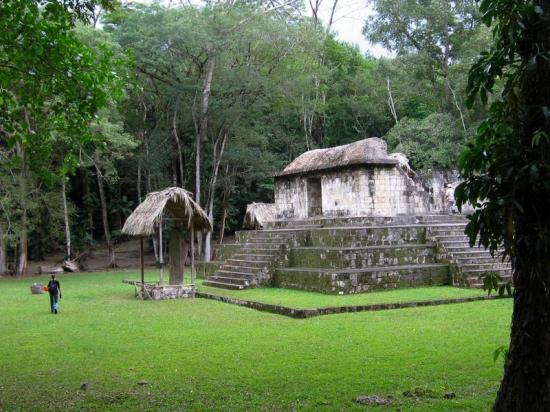A new paper uses chemistry to shed light on the management of Maya animal
Ryan P. Smith
Source - https://www.smithsonianmag.com/smithsonian-institution/dogs-were-transported-across-great-distances-ancient-maya-rituals-180968536/

 Smithsonian Tropical Research Institute archaeologist Ashley Sharpe contemplates the Ceibal site in Guatemala—one of the oldest Maya sites known. (Ashley Sharpe, STRI)
Smithsonian Tropical Research Institute archaeologist Ashley Sharpe contemplates the Ceibal site in Guatemala—one of the oldest Maya sites known. (Ashley Sharpe, STRI)
Few archaeological sites carry the eerie mystique of Ceibal, a clifftop clearing in northern Guatemala looking out on the Pasión river hundreds of feet below. Shrouded from the outside world by a cloak of tall trees, the expansive enclave is carved by centuries-old causeways. At the heart of it all, amid long-disused plazas and mounds that once supported Maya homes, sit the stony, rain-weathered remains of a temple, a serene reminder of a bloody tradition: ritual animal sacrifice.
Among the most common animals sacrificed by the Maya in honor of their pantheon was the humble dog, a creature whose domestication in Guatemala dates to a time long before the Common Era. It is the dogs of Ceibal, as well as other notable animal specimens such as big cats, peccaries, and turkeys, that are the focus of just-published research in the Proceedings of the National Academy of Sciences.
Ashley Sharpe, the Smithsonian Tropical Research Institute scientist who spearheaded the project, has been finding and aggregating remains in the region since 2010. The specimens described in the paper, 78 in all, were mostly exhumed between 2010 and 2012. A majority of the bones and teeth uncovered date to the Maya Middle Preclassic period: 700-350 B.C.
The specific aim of Sharpe’s team was to determine which animals of Ceibal had been domesticated, and which, if any, had been brought to the site from remote locations. “Animal domestication is big in the Middle East,” says Sharpe, who has experience with Old World archaeology in Syria, “but we don’t understand it as well over here in South America.” She wanted to get a better sense of the role animals played in Maya society, and the extent to which they were controlled by humans.
 Dog bones were found at the lowest levels of two pits, each within a pyramid at the Ceibal site. (Ashley Sharpe, STRI)
Dog bones were found at the lowest levels of two pits, each within a pyramid at the Ceibal site. (Ashley Sharpe, STRI)
In order to answer these questions, the scientists turned their attention to chemical forensics, looking at the isotopic content of the animal remains to draw conclusions about the fauna’s diet and place of origin. In particular, they considered isotopes of elements essential to organic matter: carbon, nitrogen, oxygen and strontium.
“Carbon can tell you what kind of plant material an animal was eating,” Sharpe explains. “Corn leaves a very different isotopic signature than most other plants.” Detecting signs of corn in the diet of the deceased animals was key to the research effort, because appreciable ingestion of a human-cultivated crop strongly suggests domestication. Nitrogen and oxygen isotopes played similar, supporting roles in the analysis, hinting at “how much meat a given animal was eating” and “what kind of water an animal was drinking,” respectively.
Strontium isotopes served as the most useful clues in determining the geographical histories of the specimens. “Strontium comes from the underlying bedrock,” Sharpe says. “Different rock has different strontium values.” An animal feeding in one part of Guatemala that was suddenly relocated would retain strontium traces pointing back to its place of origin—notably in its teeth. “Tooth enamel, once it forms, is set for life,” Sharpe says. “If you get a certain strontium value for your teeth, and you move, the value stays with you.”
The team’s work confirmed that all of Ceibal’s preserved dogs had been raised on Maya crops by humans—they were domesticated. What’s more, Sharpe was excited to discover via strontium analysis that two of the dogs were brought to Ceibal from volcanic highlands over 100 miles south, presumably for ritual purposes. She says this is the earliest evidence of dogs being traded for and moved around the Americas. Prior to this study, the first-known instance was some 1,400 years after these specimens lived, when canines were transported by boat throughout the Caribbean.
One feline specimen—most probably a jaguar—also proved surprisingly intriguing. Its lifelong corn-based diet led Sharpe to conclude that it was likely a “cat raised by the community.” She says that the adoption of wild big cats in Guatemala, which continues (illegally) to this day, is a tradition anchored in ancient Maya culture. “We see it in the Maya art sometimes,” she says, “leaders holding jaguar cubs.” The isotopes suggest that this cat was one such honored captive.
All in all, Sharpe is thrilled with the results, and eager to move forward with her work. If she had had the budget, she says, she would have analyzed thousands of specimens—but even among the dozens represented in the paper, ample surprises have emerged to titillate the scientific community. “People were managing animals or manipulating them way more than we thought,” she says, “and it was going on a lot earlier than we thought.”